For whatever flavor of
creamer you want, you start off with the same basic ‘base’ recipe.
14oz
sweetened condensed milk
1 3/4 cup milk or cream (whole, lowfat, skim,
almond, soy, heavy cream, half & half etc – whatever your preference,
however the more fat, the more creaminess)
Mix the ingredients together
well. Add them to a mason jar and shake it like crazy or you could also opt to
use an old (washed) creamer container.
French Vanilla Creamer
2
teaspoons vanilla extract OR vanilla coffee syrup
Vanilla Bean Coffee
Creamer
2 teaspoons vanilla bean paste
Chocolate
2-3 tablespoons
chocolate syrup
(1 tsp vanilla extract, optional)
Chocolate
Almond
1 tablespoon cocoa powder
1 teaspoon almond
extract
Strudel
1 tablespoon cinnamon
1 teaspoon vanilla
extract
1 teaspoon almond extract
Vanilla Caramel
2 tablespoons
caramel ice cream topping
2 teaspoons vanilla extract
Chocolate
Raspberry
2 teaspoons cocoa powder
2 tablespoons raspberry
syrup
Irish Cream
2 tablespoons chocolate syrup
1 teaspoon
instant coffee
1-2 teaspoons vanilla extract
1 teaspoon almond
extract
Coconut
2 teaspoons coconut extract
Samoa (like the
Girl Scout Cookies)
2 teaspoons coconut extract (or sub coconut milk or
cream of coconut, heated & strained, for the milk/cream)
2 tablespoons
chocolate syrup
2 tablespoons caramel ice cream topping
Peppermint
Patty
2 tablespoons chocolate syrup
1 teaspoon peppermint
extract
Cinnamon Vanilla
2 teaspoons cinnamon
2 teaspoons vanilla
extract
Pumpkin Spice
3 tablespoons pureed pumpkin
1 teaspoon
pumpkin pie spice
4 tablespoons maple syrup
1 teaspoon vanilla
extract
Honey Vanilla
1/4 cup honey
2 teaspoons vanilla
extract
Almond Joy
1-2 teaspoons coconut extract (or sub coconut
milk or cream of coconut if you heat it first, strained, in place of the milk
& extract)
1 teaspoon almond extract
2 tablespoons chocolate
syrup
Sweet Cream
Use 1 3/4 cups of heavy cream instead of the milk
in the base recipe
2 teaspoons vanilla extract OR the inside of a vanilla
bean, scraped
1 teaspoon almond extract
Chocolate Orange
2
tablespoons chocolate syrup
1-2 teaspoons orange
extract
Hazelnut
2 teaspoons hazelnut extract
Chocolate
Hazelnut
2 tablespoons chocolate syrup
2 teaspoons hazelnut
extract
Cinnamon Cake
2 teaspoons cinnamon
2 teaspoons vanilla
extract
Salted Caramel
2-3 tablespoons caramel ice cream
topping
1/2 teaspoon salt
Eggnog
replace milk in base recipe with
equal amount of heavy cream
1 teaspoons vanilla extract
2 teaspoons rum
extract
1 teaspoon ground nutmeg
Toasted Almond
2 teaspoons
almond extract
Directions & Tips:
In all these recipes, anything
that has a dry or thick ingredient (like cinnamon, honey, etc..) should be
heated up with a small amount of your milk/cream from the base recipe so it
can dissolve properly. You don’t want grainy creamer! Then, add the rest of
the milk/cream along with the sweetened condensed milk.
If you want
really creamy creamer, use heavy cream instead of milk in your base
recipe.
You'll want to stick a piece of tape on they mason jar lid with
the expiration date from the milk used. Use this as a guideline as to when the
creamer should be used by.
Please feel free to play around with amounts
of extracts and other ingredients used if you like stronger or less intense
flavors!! And, let your imagination turn, and make up your own combinations.
Use this as inspiration to create your very own perfect homemade flavored
creamer!
Saturday, September 7, 2013
Wednesday, March 20, 2013
Atomic Gardening: Breeding Plants With Gamma Radiation
Did you know that the peppermint flavor in your chewing gum and toothpaste, and the red-ruby grapefruit on your plate, is the result of mutation caused by deliberate irradiation? Apparently, after World War II, there was a concerted effort to find peaceful uses for atomic energy. One of the ideas was to bombard plants with radiation and produce lots of mutations, some of which, it was hoped, would lead to plants that were disease or cold-resistant or just had unusual colors. The experiments were mostly conducted in giant gamma gardens on the grounds of national laboratories in the US, Europe and countries of the former USSR, leading to untold numbers of new plant varieties. The disease resistant peppermint plant and the 'Rio Star' grapefruit, which accounts for 75% of the grapefruit production in Texas, were created in these atomic gardens.

Modern genetic engineering has replaced the need for atomic gardening, but the legacy is still carried forward by the Institute of Radiation Breeding in Japan, which currently owns the largest, and possibly the only surviving gamma garden in the world, at Hitachiōmiya in Ibaraki Prefecture. The circular garden measures 100 meters in radius, and enclosed by an 8-meter high shielding dike wall. Species within are irradiated with gamma rays from a cobalt-60 source placed inside a central pole. The purpose here is to generate new traits such as tolerance to fungus infection or consumer-friendlier fruit colors, and in general, help meet demands for development of crop varieties with new traits.
Nanotechnologist Paige Johnson of the University of Tulsa, Oklahoma, who researches atomic garden history in her spare time, says: "If you think of genetic modification today as slicing the genome with a scalpel, in the 1960s they were hitting it with a hammer". Indeed, before scientist learned how to modify genes, they induced mutations with radiation and hoped for the best.
Paige describes about these gamma garden in an interview to Pruned, that is worth reading.
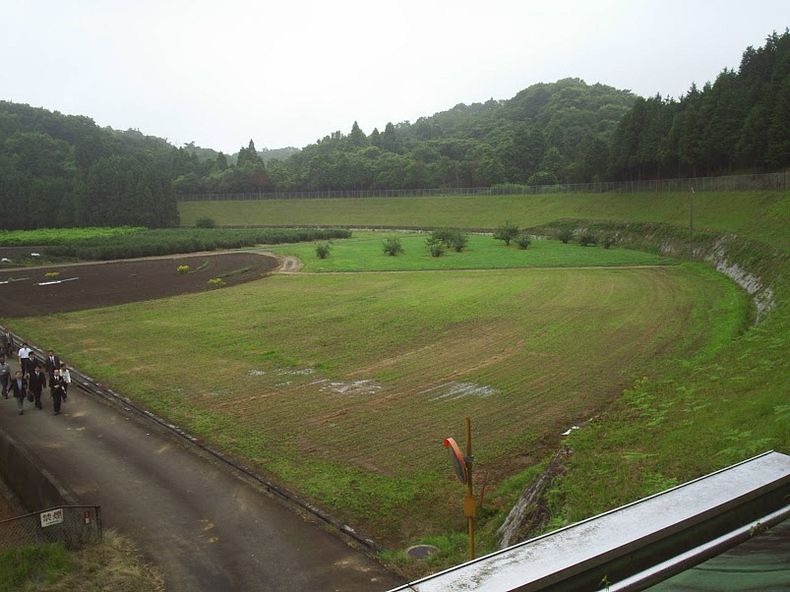
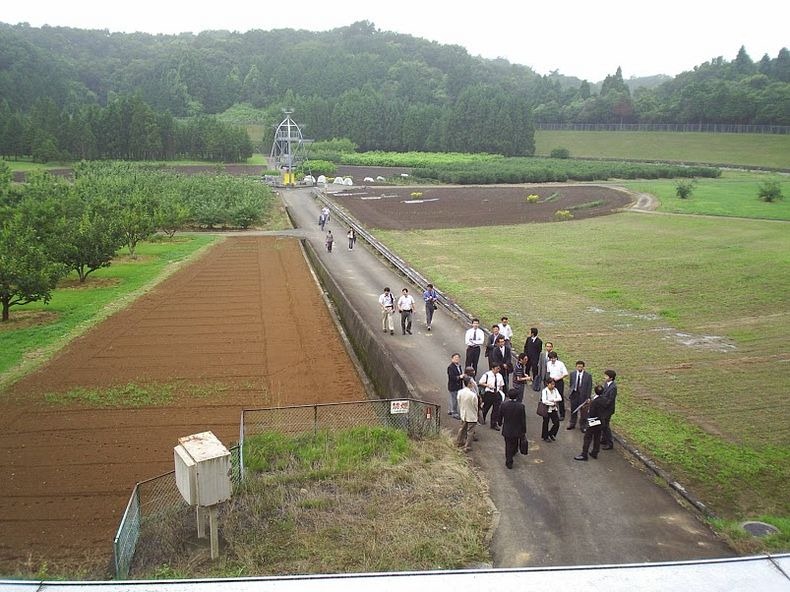

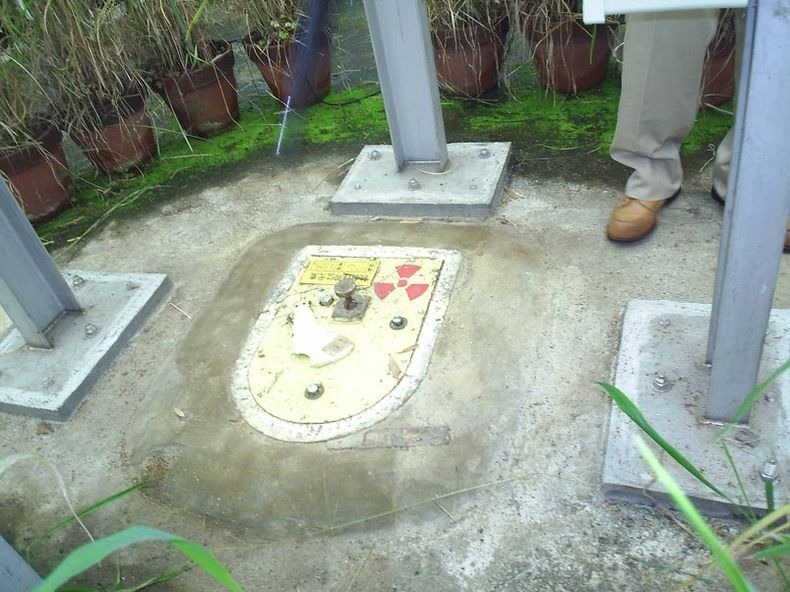
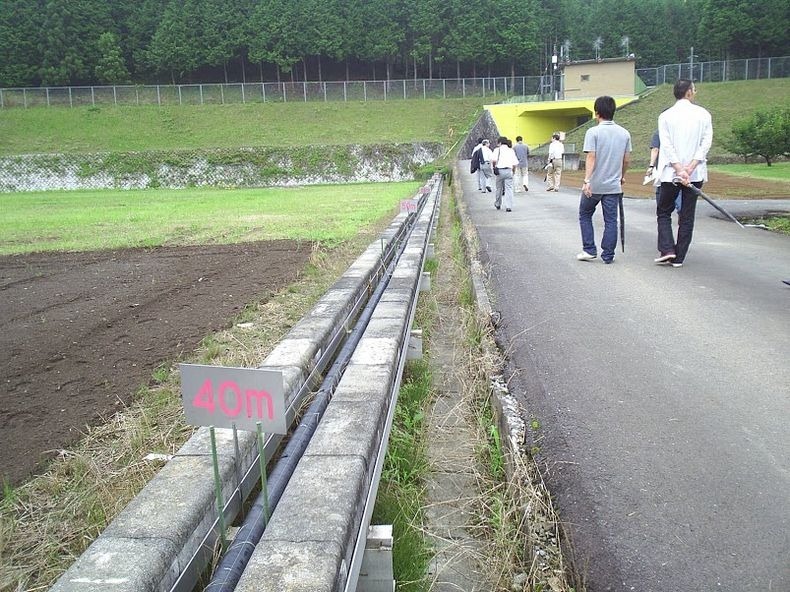
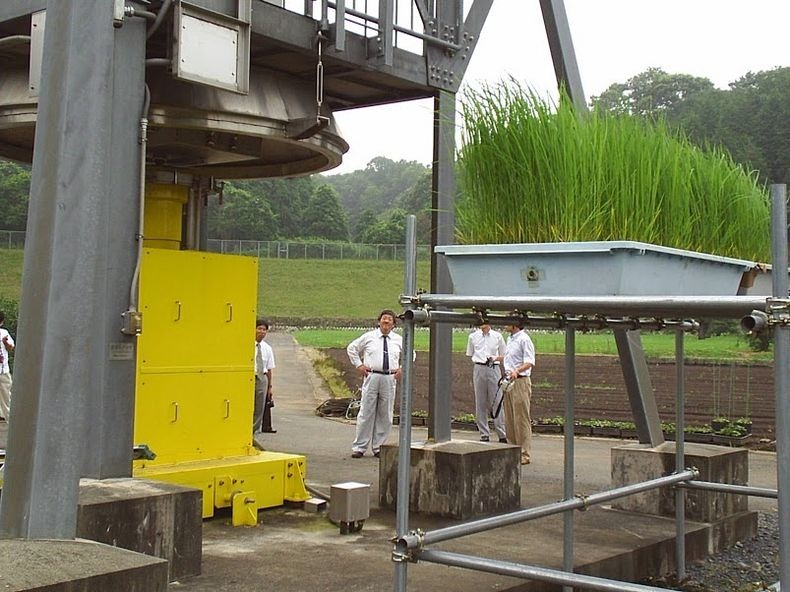
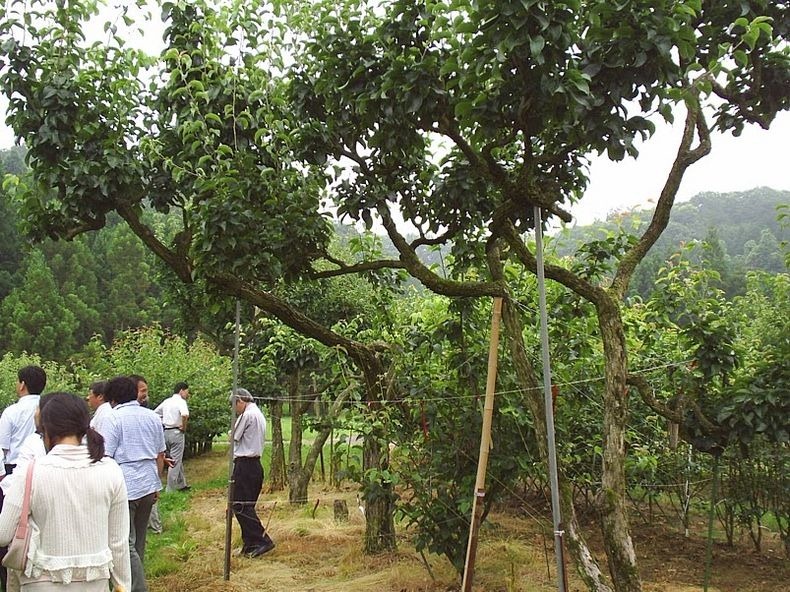
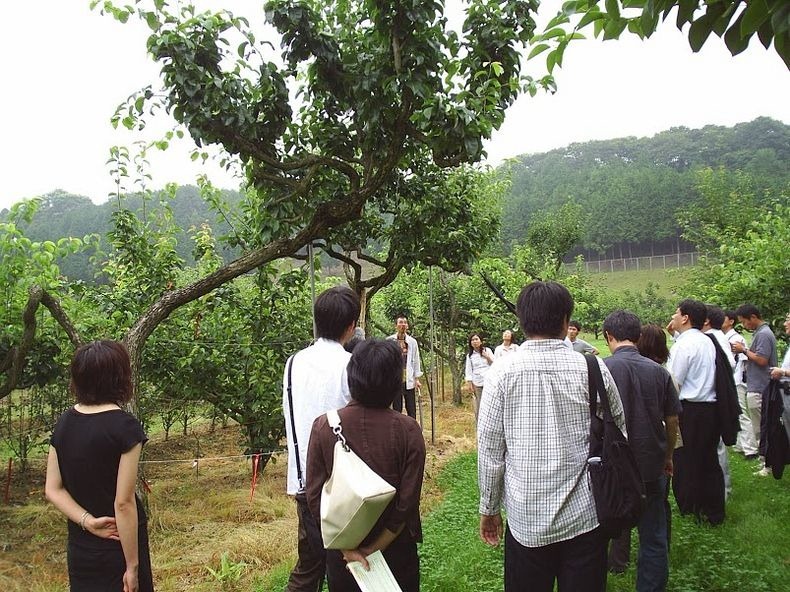

Modern genetic engineering has replaced the need for atomic gardening, but the legacy is still carried forward by the Institute of Radiation Breeding in Japan, which currently owns the largest, and possibly the only surviving gamma garden in the world, at Hitachiōmiya in Ibaraki Prefecture. The circular garden measures 100 meters in radius, and enclosed by an 8-meter high shielding dike wall. Species within are irradiated with gamma rays from a cobalt-60 source placed inside a central pole. The purpose here is to generate new traits such as tolerance to fungus infection or consumer-friendlier fruit colors, and in general, help meet demands for development of crop varieties with new traits.
Nanotechnologist Paige Johnson of the University of Tulsa, Oklahoma, who researches atomic garden history in her spare time, says: "If you think of genetic modification today as slicing the genome with a scalpel, in the 1960s they were hitting it with a hammer". Indeed, before scientist learned how to modify genes, they induced mutations with radiation and hoped for the best.
Paige describes about these gamma garden in an interview to Pruned, that is worth reading.
It was basically a slug of radioactive material within a pole; when workers needed to enter the field it was lowered below ground into a lead lined chamber. There were a series of fences and alarms to keep people from entering the field when the source was above ground.According to Dr. Lagoda, the head of plant breeding and genetics at the International Atomic Energy Agency, radiation breeding has produced thousands of useful mutants and a sizable fraction of the world’s crops, including varieties of rice, wheat, barley, pears, peas, cotton, peppermint, sunflowers, peanuts, grapefruit, sesame, bananas, cassava and sorghum.
The amount of radiation received by the plants naturally varied according to how close they were to the pole. So usually a single variety would be arranged as a 'wedge' leading away from the pole, so that the effects of a range of radiation levels could be evaluated. Most of the plants close to the pole simply died. A little further away, they would be so genetically altered that they were riddled with tumors and other growth abnormalities. It was generally the rows where the plants 'looked' normal, but still had genetic alterations, that were of the most interest, that were 'just right' as far as mutation breeding was concerned!








Atomic Gardening: Breeding Plants With Gamma Radiation
Did you know that the peppermint flavor in your chewing gum and toothpaste, and the red-ruby grapefruit on your plate, is the result of mutation caused by deliberate irradiation? Apparently, after World War II, there was a concerted effort to find peaceful uses for atomic energy. One of the ideas was to bombard plants with radiation and produce lots of mutations, some of which, it was hoped, would lead to plants that were disease or cold-resistant or just had unusual colors. The experiments were mostly conducted in giant gamma gardens on the grounds of national laboratories in the US, Europe and countries of the former USSR, leading to untold numbers of new plant varieties. The disease resistant peppermint plant and the 'Rio Star' grapefruit, which accounts for 75% of the grapefruit production in Texas, were created in these atomic gardens.

Modern genetic engineering has replaced the need for atomic gardening, but the legacy is still carried forward by the Institute of Radiation Breeding in Japan, which currently owns the largest, and possibly the only surviving gamma garden in the world, at Hitachiōmiya in Ibaraki Prefecture. The circular garden measures 100 meters in radius, and enclosed by an 8-meter high shielding dike wall. Species within are irradiated with gamma rays from a cobalt-60 source placed inside a central pole. The purpose here is to generate new traits such as tolerance to fungus infection or consumer-friendlier fruit colors, and in general, help meet demands for development of crop varieties with new traits.
Nanotechnologist Paige Johnson of the University of Tulsa, Oklahoma, who researches atomic garden history in her spare time, says: "If you think of genetic modification today as slicing the genome with a scalpel, in the 1960s they were hitting it with a hammer". Indeed, before scientist learned how to modify genes, they induced mutations with radiation and hoped for the best.
Paige describes about these gamma garden in an interview to Pruned, that is worth reading.









Modern genetic engineering has replaced the need for atomic gardening, but the legacy is still carried forward by the Institute of Radiation Breeding in Japan, which currently owns the largest, and possibly the only surviving gamma garden in the world, at Hitachiōmiya in Ibaraki Prefecture. The circular garden measures 100 meters in radius, and enclosed by an 8-meter high shielding dike wall. Species within are irradiated with gamma rays from a cobalt-60 source placed inside a central pole. The purpose here is to generate new traits such as tolerance to fungus infection or consumer-friendlier fruit colors, and in general, help meet demands for development of crop varieties with new traits.
Nanotechnologist Paige Johnson of the University of Tulsa, Oklahoma, who researches atomic garden history in her spare time, says: "If you think of genetic modification today as slicing the genome with a scalpel, in the 1960s they were hitting it with a hammer". Indeed, before scientist learned how to modify genes, they induced mutations with radiation and hoped for the best.
Paige describes about these gamma garden in an interview to Pruned, that is worth reading.
It was basically a slug of radioactive material within a pole; when workers needed to enter the field it was lowered below ground into a lead lined chamber. There were a series of fences and alarms to keep people from entering the field when the source was above ground.According to Dr. Lagoda, the head of plant breeding and genetics at the International Atomic Energy Agency, radiation breeding has produced thousands of useful mutants and a sizable fraction of the world’s crops, including varieties of rice, wheat, barley, pears, peas, cotton, peppermint, sunflowers, peanuts, grapefruit, sesame, bananas, cassava and sorghum.
The amount of radiation received by the plants naturally varied according to how close they were to the pole. So usually a single variety would be arranged as a 'wedge' leading away from the pole, so that the effects of a range of radiation levels could be evaluated. Most of the plants close to the pole simply died. A little further away, they would be so genetically altered that they were riddled with tumors and other growth abnormalities. It was generally the rows where the plants 'looked' normal, but still had genetic alterations, that were of the most interest, that were 'just right' as far as mutation breeding was concerned!








Tuesday, March 5, 2013
PINEAPPLE BENEFITS
The pineapple is a member of the bromeliad family.
It is extremely rare that bromeliads produce edible fruit. The pineapple is
the only available edible bromeliad today.
It is a multiple fruit. One pineapple is actually made up of dozens of
individual floweret's that grow together to form the entire fruit. Each
scale on a pineapple is evidence of a separate flower.
Pineapples stop ripening the minute they are picked.
No special way of storing them will help ripen them further.
Color is relatively unimportant in determining ripeness.
Choose your pineapple by smell.If it smells fresh, tropical and
It is extremely rare that bromeliads produce edible fruit. The pineapple is
the only available edible bromeliad today.
It is a multiple fruit. One pineapple is actually made up of dozens of
individual floweret's that grow together to form the entire fruit. Each
scale on a pineapple is evidence of a separate flower.
Pineapples stop ripening the minute they are picked.
No special way of storing them will help ripen them further.
Color is relatively unimportant in determining ripeness.
Choose your pineapple by smell.If it smells fresh, tropical and
sweet, it will be a good fruit.
The more scales on the pineapple, the sweeter and juicier the taste.
After you cut off the top, you can plant it.
It should grow much like a sweet potato will.
This delicious fruit is not only sweet and tropical; it also offers many
benefits to our health. Pineapple is a remarkable fruit.
We find it enjoyable because of its lush, sweet and exotic flavor, but it
may also be one of the most healthful foods available today.
If we take a more detailed look at it, we will find that pineapple is
valuable for easing indigestion, arthritis or sinusitis.
The juice has an anthelmintic effect; it helps get rid of intestinal worms.
Let's look at how pineapple affects other conditions.
Pineapple is high in manganese, a mineral that is critical to development of
strong bones and connective tissue. A cup of fresh pineapple will give you
The more scales on the pineapple, the sweeter and juicier the taste.
After you cut off the top, you can plant it.
It should grow much like a sweet potato will.
This delicious fruit is not only sweet and tropical; it also offers many
benefits to our health. Pineapple is a remarkable fruit.
We find it enjoyable because of its lush, sweet and exotic flavor, but it
may also be one of the most healthful foods available today.
If we take a more detailed look at it, we will find that pineapple is
valuable for easing indigestion, arthritis or sinusitis.
The juice has an anthelmintic effect; it helps get rid of intestinal worms.
Let's look at how pineapple affects other conditions.
Pineapple is high in manganese, a mineral that is critical to development of
strong bones and connective tissue. A cup of fresh pineapple will give you
nearly 75% of the recommended daily amount.
It is particularly helpful to older adults, whose bones tend to become
brittle with age.
Bromelain, a proteolytic enzyme, is the key to pineapple's value.
Proteolytic means "breaks down protein", which is why pineapple is known to
be a digestive aid. It helps the body digest proteins more efficiently.
Bromelain is also considered an effective anti-inflammatory.
Regular ingestion of at least one half cup of fresh pineapple daily is
purported to relieve painful joints common to osteoarthritis. It also produces mild pain relief.
In Germany , bromelain is approved as a post-injury medication because it is
thought to reduce inflammation and swelling.
Orange juice is a popular liquid for those suffering from a cold because it
is high in Vitamin C. Fresh pineapple is not only high in this vitamin, but because of the Bromelain, it has the ability to reduce mucous in the throat.
If you have a cold with a productive cough, add pineapple to your diet.
It is commonly used in Europe as a post-operative measure to cut mucous
after certain sinus and throat operations.
Those individuals who eat fresh pineapple daily report fewer sinus problems
related to allergies. In and of itself, pineapple has a very low risk for allergies.
Pineapple is also known to discourage blood clot development. This makes
It is particularly helpful to older adults, whose bones tend to become
brittle with age.
Bromelain, a proteolytic enzyme, is the key to pineapple's value.
Proteolytic means "breaks down protein", which is why pineapple is known to
be a digestive aid. It helps the body digest proteins more efficiently.
Bromelain is also considered an effective anti-inflammatory.
Regular ingestion of at least one half cup of fresh pineapple daily is
purported to relieve painful joints common to osteoarthritis. It also produces mild pain relief.
In Germany , bromelain is approved as a post-injury medication because it is
thought to reduce inflammation and swelling.
Orange juice is a popular liquid for those suffering from a cold because it
is high in Vitamin C. Fresh pineapple is not only high in this vitamin, but because of the Bromelain, it has the ability to reduce mucous in the throat.
If you have a cold with a productive cough, add pineapple to your diet.
It is commonly used in Europe as a post-operative measure to cut mucous
after certain sinus and throat operations.
Those individuals who eat fresh pineapple daily report fewer sinus problems
related to allergies. In and of itself, pineapple has a very low risk for allergies.
Pineapple is also known to discourage blood clot development. This makes
An old folk remedy for morning sickness is fresh pineapple juice.
it really works! Fresh juice and some nuts first thing in the morning often
make a difference.
Sunday, January 13, 2013
Twinkie Recipes
Super Easy Cake Mix Twinkie Recipe
Cake:4 eggs
1/2 cup (1 stick) margarine or butter, melted and cooled to lukewarm
1 cup water
1 (5.1 ounce) package instant vanilla pudding mix
1 (18.25 ounce) package yellow cake mix
Filling:
1/2 cup (1 stick) margarine or butter, room temperature
1 (8 ounce) package cream cheese, or tofutti cream cheese room temperature
5 cups confectioners’ sugar, sifted
1 cup (8 ounce) whipping cream or non-dairy whipping cream,
1 teaspoon vanilla extract
Preheat an oven to 350 degrees. Grease and flour two 10×15 inch jelly roll pans.
Beat the eggs until combined; stir in the melted margarine or butter. Add the water, pudding mix, and yellow cake mix, stirring well to combine. The batter will be very thick. Divide the batter between the prepared pans, spreading it evenly.
Bake until the cakes spring back when pressed lightly with a finger or a tester comes out clean, 15 to 20 minutes. Cool completely on wire racks.
To make the filling, combine margarine or butter, cream cheese, and confectioners’ sugar. Beat until smooth. Stir in the whipped cream and vanilla extract.
When the cakes are cool, spread the filling mixture on top of one cake layer. Place the second cake layer on top of the first, and place in the freezer for 15 minutes (this will make the filling a little stiffer so they will stay intact while cutting). Take them out and cut into bars. Wrap each bar in plastic wrap and store in the freezer until ready to serve. Thaw for thirty minutes before serving.
Homemade Twinkies

This one is made with corn meal so it has a yellow color just like the original.
8 ounces (two sticks) unsalted butter (melted) or margarine
2 cups sugar
4 large eggs
2 ¾ cups all purpose flour
¼ corn meal
1 tablespoon baking powder
1 teaspoon baking soda
1 ½ teaspoon kosher salt
1 ¼ cups buttermilk (or 1 cup and 1 tablespoon non-dairy creamer PLUS 3 tablespoons white vinegar for pareve equivalent)
Whisk together butter, sugar, eggs and buttermilk. Fold in dry ingredients. Spoon into prepared moulds and bake at 350 for about 20 minutes. Once cool, trim the tops and inject filling.
If you made in muffin cups, either in just filling or scoop out some of the center of the muffin and fill with filling.
Filling
16 ounces cream cheese or tofutti cream cheese
1 cup powdered sugar
¼ cup whipping cream, whipped
1 vanilla bean scraped and pod discarded (optional, but tasty)
In a mixer, beat cream cheese until light and fluffy. Add in powdered sugar and mix on low speed so that it does not fly all over the kitchen. Fold in whipping cream and vanilla bean.
Subscribe to:
Posts (Atom)